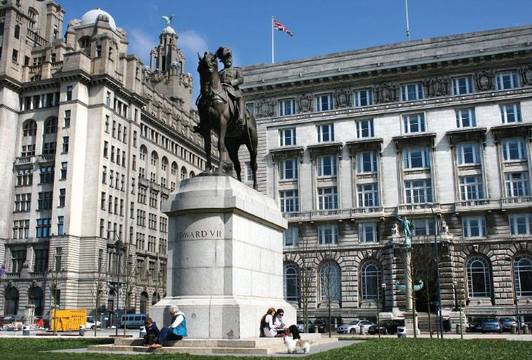
We asked curator Inga Fraser to choose five pieces of artwork she loves at Tate Britain for BHT readers. "We do have many artists who engage with history," she answered. Here are her choices:
1) Ben Nicholson, 1932 (Auberge de la Sole Dieppoise), 1932
This painting depicts the likeness of Barbara Hepworth, Nicholson's partner, reflected in the window of a modest hotel-restaurant in the summer of 1932. Nicholson was bringing modernist ideas from the continent back to Britain.
Curator Inga Fraser: “The first thing to note is the palette--that he appropriates this palette of the cubists, which was quite dull in tone. It’s subtle tones of blues, grays and browns. He does this in order to give the different components of the composition equanimity within the pictorial space, and it highlights this element of flattening, which lends itself to a decorative context. That’s something that Nicholson and Hepworth were very much inspired by: how painting and design can become one.”

A graffiti covered wall
2) John William Waterhouse, The Lady of Shalott, 1888
This painting illustrates the following lines from Part IV of Tennyson’s poem The Lady of Shalott:
And down the river’s dim expanse
Like some bold seer in a trance,
Seeing all his own mischance –
With glassy countenance
Did she look to Camelot.
And at the closing of the day
She loosed the chain, and down she lay;
The broad stream bore her far away,
The Lady of Shalott.
Fraser: “Tate Britain was founded in the late 19th century, so it collected the many works of that time which were looking back to an even earlier period of British history: the medieval period. This is a medieval scene, yet painted in the late 19th century. In every point in the history of British art, you have these artists who are looking back to Britain's own history."
We asked Fraser what she personally loves about this piece. "She's obviously an incredibly beautiful woman and I just love that kind of exuberance. That romanticism—that unbridled romanticism of the painting. Look at the rich embroidered tapestry she wears! It’s a literary scene and everything is symbolic—the boat, the candles, the lantern.”
But wasn't she sent to her death?
“Yes, exactly!” she replied. “That’s why it’s so sad—and romantic!”

N01543
3) John Singer Sargent, Ena and Betty, Daughters of Asher and Mrs Wertheimer, 1901
This painting of the elder daughters of Asher Wertheimer is a fine example of how Sargent, an American, made quite a bit of money--with portraits of the wealthy. The painter befriended the Wertheimer family and painted at least a dozen likenesses of them and Wertheimer, an art dealer, helped Sargent obtain commissions.
Fraser: "At this point, around the turn of the century, there's a whole social phenomenon of English aristocratic families who are impoverished and needed money, and then you had the daughters of rich foreigners. It's not just in literature. It is the truth. This is particularly how they would have wanted to be painted. It's exquisite the way he paints fabric. I mean, you can see the way he's picked up these patches of light and almost actually likening the hourglass figures of the two sisters to the hourglass shape of the vase, and, again, picking up the same light."
When we made note of one of the girls' exceptionally long arms, Fraser added, "He was a flatterer. Long graceful arms. Perhaps longer and more graceful than they were in real life."
4) J.M.W. Turner, Norham Castle, Sunrise, circa 1845
No one, of course, needs any convincing to view the works of Turner, one of the undisputed masters of English painting, but we'll give you some information from the display caption: "Turner first saw Norham, bordering Scotland on the river Tweed in Northumberland, in 1797. He was at the limits of his trip to northern England, when he also visited Buttermere.... After that first visit he made watercolours showing the ruin at sunrise, and visits in 1801 and 1831 resulted in further views. Here, finally, is one of a series of unfinished, unexhibited paintings reworking his monochrome Liber Studiorum landscape prints. Pure colours rather than contrasting tones express the blazing light as the historic building and landscape merge."
Fraser: "I couriered works from this touring exhibition back to the U.K. in February. (When works are very fragile or expensive, they have to be accompanied throughout their journey–so I saw them come off the walls in Toronto, Canada, and traveled by aeroplane and lorry via Amsterdam back to the Tate."

NorhamCastleSunrise-turner
5) Paule Vézelay, Five Forms, 1935
Paule Vézelay made a small number of white plaster sculptures in Paris in 1935. Five Forms was exhibited in 1938 as Quatre objets sur une forme ovale (Four Objects on an Oval Form). It is the finest and largest surviving example.

A white plate with a knife
Inga Fraser says: "[At this time] sculpture starts increasingly interacting with architecture and starts incorporating space. So, for instance, they would have particularly paid attention to the way these forms were placed on the white surface. You know, the spaces between them, how they relate to one another; that is something distinct. If you think of 19th-century sculpture. it is concerned with one figure, as a sole item, which could be placed anwhere. With this one, you're encouraged to think of the idea of space as integral to the sculpture itself."
All images are courtesy of the museum. To see these works and much more visit Tate Britain.






Comments